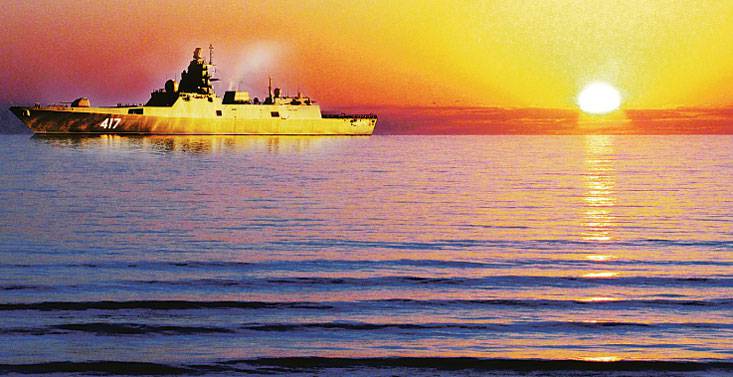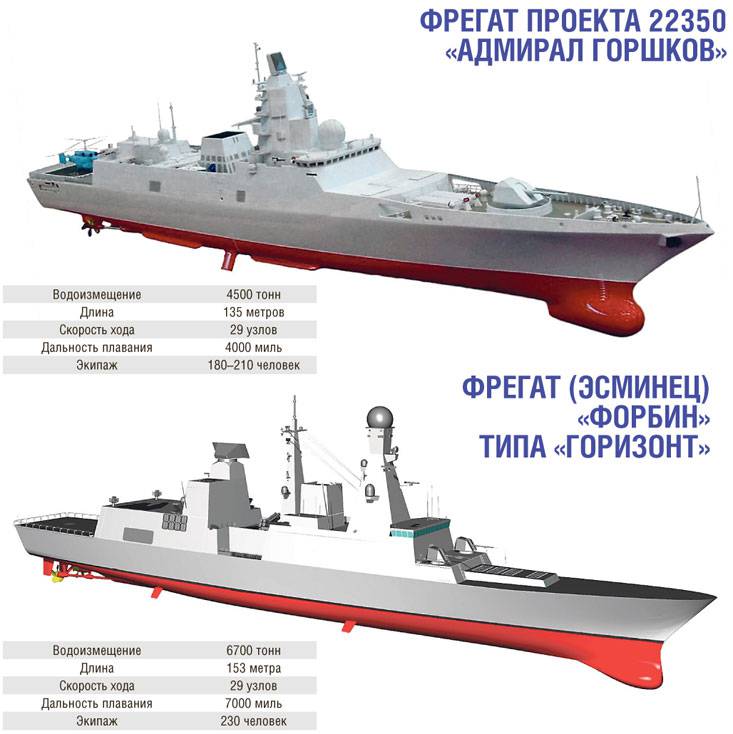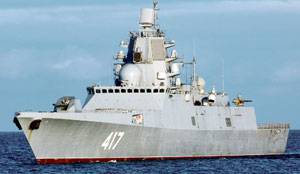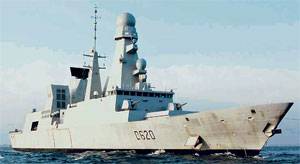Ours over "Horizon"
The evolution of the destroyers led to the emergence of two modern classes of ships. These are large destroyers, which approached cruisers in displacement, and frigates. Both classes are universal, combining both escort and shock capabilities, including in terms of destruction of ground objects. Both are intended for actions in the distant sea and ocean zones - individually or as part of large ship operational connections.
The increase in the displacement of destroyers and the subsequent allocation of frigates into a special class are due to the need to deploy powerful combat information and control systems, developed defensive and strike weapons. The United States, which at one time paid great attention to the frigates, eventually abandoned their construction and concentrated on destroyers (bringing their displacement to 14, 000 tons, as is the case with Zamvolta). This was due to the need to ensure the actions of large operational units (primarily aircraft carriers) in remote areas of the oceans, including off the coast of the enemy, as well as the availability of funds for such projects. Other countries that do not possess similar capabilities and do not claim to have a global projection of power continue to develop the class of frigates. This also applies to NATO members with a developed shipbuilding industry.
In the near future, our Navy will receive only frigates for operations in the distant sea zone, primarily the 22350 project. Prospective destroyers of the type "Leader" and larger ships are still in the process of formulating tactical and technical requirements. Therefore, representatives of the 22350 (and 11356) project will be the only modern surface ships of the distant sea and ocean zones, which in sufficiently large quantities will go into service with our fleets.

In this regard, it is interesting to compare domestic and foreign, primarily NATO, schools in terms of the development of frigates. Earlier in Russia / USSR, they were not built, their role was played by less universal guard ships, including those of the ocean zone, and the TFR of the 2 rank of the 1135 project. The first of our full frigate should be considered the project 22350. His and take for comparative analysis.
As opponents, it is advisable to choose a ship from the composition of the NATO Navy that is adequate in purpose, composition of weapons and characteristics, preferably the newest built. These conditions satisfy the frigates of the type "Horizon". They are also interesting because they are the product of the joint development of France, Italy and the UK (although the latter left the project at the final stage, its destroyer Daring is actually a version of the same Horizon).
Compare the characteristics
Our ship with a full displacement of about 4500 tons has a hull, made using the technology of "Stealth", which allowed at times to reduce the effective area of dispersion of the ship, and accordingly its radar and optical visibility. The strike armament complex is represented by 16 units of the Onyx anti-ship missiles, located in two universal vertical launch complexes 3С14У1. Instead of "Onyx" in the cell can be loaded missiles of the family "Caliber-NKE" in anti-ship and anti-submarine versions, as well as in the configuration for firing at ground targets. Thus, the frigate is regarded as a multi-purpose, capable of solving the tasks of destroying enemy surface ships and destroying its infrastructure on the coast.
According to open sources, anti-aircraft missile weapons are represented by the Polymer-Redut air defense system. His missiles are located in four eight-cell modules. Full ammunition can include 9М96 and 9М96Х2 (up to 120 km) one per cell (total 32 missiles) or 9М100 self-defense missile (firing range - about 10 km) for four of the way of the 4-ths of the world, four X-9X128 self-defense missiles (up to about XNUMX km) or four XNUMX self-defense missiles (XNUMX km), or four XNUMX XNUMX XNUMX XNUMX XNUMX XXNUMX XXNUMX XXNUMX XXNUMX XXNUMX XXNUMX XXNUMX XXNUMX XXNUMX XXNUMX XXNUMX XXNUMX XXNUMX XMXNUMX XMXNUMX XNUMX XMXNUMX XMXNUMX XMXNUMX self-defense missiles ). To defeat airborne targets in the zone of self-defense, the frigate is equipped with two “Palash” SIGNS, placed along the sides next to the helicopter hangar.
To defeat submarines designed missile system "Medvedka-2". Two of its launchers are located side by side, with four PLRs in each - a total of eight missiles.

The ship’s artillery armament is represented by the 130-mm A-192 artillery mount, which has a range of up to 22 kilometers and a rate of fire of up to 30 rounds per minute. The control system (5P-10 “Puma”) and the range of ammunition allow it to be used to destroy coastal, sea and air targets. Aviation the frigate’s weapons are represented by a Ka-27 helicopter, for which there is a deck hangar. According to Western experts, for the destruction or incapacitation of such ships it is enough to hit one or two anti-ship missiles “Harpoon” or one “Tomahawk”.
The frigate "Horizon" of the French Navy with a displacement of about 7000 tons as the main armament has eight MM40 Exocet or Teseo (Otomat) Mk 3 anti-ship missiles (both with a range of up to 180 km). In UVP on 48 cells are placed missiles SAM PAAMS Aster 15 (range - up to 30 km) or Aster 30 (range - up to 120 km). Currently, a ship version of the SCALP-EG aircraft missile is being developed, which should reach a range of ground targets up to a thousand kilometers (approaching this indicator to the US Tomahawk), and up to 250 kilometers over sea. It is supposed to place it in UVP instead of Zour. Universal artillery is represented by three 76-mm AU Oto Melara. There is one six-barreled 25-mm AU SADRAL Oto Melara Mod 503 in the self-defense zone for the destruction of the air defense system. Anti-submarine armament includes two twin-tube units TA MU 90 for small torpedoes. The ships have powerful hydroacoustic submarine search tools (GAS TMS 4110CL) and anti-submarine helicopters (Merlin EH101 HAS). For the withdrawal of such a frigate or its sinking may require one or two anti-ship missiles with a warhead of 300 – 400 kilograms.

Comparison of the tactical and technical characteristics of the ships indicates that our strength is the long-range missile and long-range missile defense, our 130-mm universal AU, as well as the anti-submarine missile system. Horizon has no equivalent systems. weapons. The ship version of the SCALP-EG rocket is still a prospect, moreover, very dubious considering the economic problems of the EU.
However, a simple comparison of characteristics is not enough for a correct comparison of ships. It is necessary to evaluate their capabilities in the likely conditions of combat use, taking into account their purpose.
In this regard, it is worth considering two options: the actions of the compared ships in a local war against a weak naval enemy in the interests of the air force and naval forces, or in a large-scale Russia-NATO war. It makes sense to calculate the following variant of the collision: our frigate against NATO as part of the ship's shock group (KUG).
Compare opportunities
In these conflicts, in general, both ships will solve the following main tasks, according to which we will compare: the destruction of groups of ships (KUG, KPUG) and submarines, repelling the enemy’s air attack, striking its ground targets.

In a local war against a weak naval country, the task weights (taking into account the probability of their occurrence) for a Russian ship can be evaluated as follows: destruction of groups of surface ships and boats - 0,1, submarines - 0,05, attack of air attack - 0,3, strikes for ground targets of the enemy in the operational depth - 0,5, for objects of antiamphibious defense - 0,05.
The “Horizon” in the modern version does not have strategic cruise missiles. Therefore, for him, the distribution of task weights in a limited war looks somewhat different: the destruction of groups of surface ships and boats - 0,3, submarines - 0,15, repelling an air attack - 0,4, strikes against anti-amphibious defense objects - 0,15.
In a large-scale war, the significance of task weights for the Gorshkov is as follows: the destruction of groups of surface ships (KUG, KPUG) - 0,2, submarines - 0,2, repelling air attack - 0,3, strikes against ground targets in operational depth - 0,25, anti-landing targets Defense - 0,05. For "NATO": the destruction of groups of surface ships (KUG, KPUG) - 0,18, submarines - 0,3, repelling enemy air attacks - 0,5, strikes against ground targets and anti-airborne defense systems - 0,02.
Now we estimate the capabilities of the frigates to solve typical tasks. The first is the destruction of groups of surface ships and boats. It is perfectly clear that frigates are significantly inferior in terms of combat capabilities to cruisers and destroyers, which will form the basis of the CCG and aircraft escort ships. Therefore, participation in strikes against groups of ships of this class is a non-standard task for them. More probable and feasible will be strikes against groups of ships of equal value or lower classes. These are ship search and strike groups (KPUG), hunting for submarines in the designated area, or shock groups of MRKs (corvettes) and missile boats. Therefore, as an example for comparison, we will consider a typical KPUG (KUG of corvettes) consisting of three to four units.
The Russian frigate, having more than twice the superiority in the range of missile weapons (Onyx and Caliber-NKE) over the target of the attack, all other things being equal, can go into a salvo position and fire, remaining out of reach of the enemy. 16-rocket salvo provides for the destruction or destruction of ships of typical KPUG or KUG with probability 0,76 – 0,8.
"Horizon" has a missile system with a range of fire almost equal to that which the strike object has (on the corvettes and frigates of the enemy, either the same "Exosets" or the latest modifications of "Harpoons" may be in service). In the event of an advance of the enemy in the salvo, he will be able to disable or destroy ships from the composition of a typical KPUG or KUG with a probability 0,4 – 0,48. But the opposing side has the same chances. Thus, the reduced probability decreases to 0,23 – 0,35.
In strikes against ground targets, our frigate can use “Caliber” missiles of that modification, which was demonstrated in Syria. Naturally, tactical scale tasks will be set for the frigate, that is, the destruction of one important object or group of three or four small ones. By using the Caliber missile, the Gorshkov will be able, within the effective shooting range (up to 2000 km), to solve the 16 rocket volley with a probability of 0,55 – 0,7.
In addition, our ship is able to suppress one company-based strong point in the antiamphibious defense system on the coast at a distance of up to 10 – 15 kilometers from the water's edge with a probability of 0,6 – 0.7.


"Horizon" does not have weapons for strikes against targets in the operational depth, therefore its capabilities in this regard are zero. Under certain conditions, he, of course, will be involved in strikes against objects of antiamphibious defense on the coast to a depth of five to six kilometers. If we consider the same company support point, the probability of its suppression by three 76-mm AU "Horizon" will not exceed 0,15 – 0,2 in the most favorable scenario.
It is advisable to make an assessment of the capabilities of frigates to combat submarines by the criterion of the probability of detecting and destroying an enemy submarine in a given area as part of a typical GTC of three frigates. Usually, the search area is defined so that the KPUG is capable of detecting and destroying enemy submarines in it with a given probability. This indicator depends on many factors, but when comparing different ships, the most important of them is the energy range of a submarine's detection of a hydroacoustic complex (GAK), as well as the power of anti-submarine weapons. "Horizon" surpasses our ship in the energy range of the SJC. But significantly inferior in weapons to solve the problem. The presence of anti-submarine helicopters on both ships, which conduct an additional search and have the means of destroying submarines at long distances, to a certain extent eliminates the superiority of our ship in striking power. If for a certain period of time our frigate is able to detect and destroy an enemy submarine with a probability of 0,5, then this indicator is slightly higher at Horizon - 0,58.
It remains to assess the capabilities of ships for the defeat of air targets. Let us take as a basis the reflection of a typical EHV outfit in the 24 RCC with a three-minute salvo sweep on a warrant in which there are three escort frigates and one ship of the nucleus (for example, a cruiser with an unsettling potential of 5 air defense units). Under such conditions, the likelihood of maintaining the combat capability of our ship's order warrant may be 0,55, and in NATO, 0,61.
One on One
It is interesting to consider a dueling situation. Other things being equal, our “Potters”, due to a significant superiority in firing range, has the ability to disable or sink “Horizon” with a probability up to 0,6 – 0,7, without entering the enemy's affected area.
With mutual detection at the range of the horizon missiles, the probability of the death of our frigate will be substantially less and amount to 0,3 – 0,35. However, the likelihood of such an event is relatively small, since the “NATO member” will have to move closer to our ship in order to enter the salvo position for several hours, all this time being within the reach of his weapon.
The analysis performed allows us to derive an integral indicator of the correspondence of two ships. The Russian frigate, he is in relation to local wars 0,655, and large-scale - 0,635. At Horizon, the indicators are distributed as follows: 0,466 and 0,546, respectively. That is, our frigate surpasses our opponent by almost 41 percent in local wars and 16 percent in large-scale by the degree of compliance of the combat effectiveness of the ship with its destination. In a duel situation, our ship has a clear advantage due to a significant superiority in the range of weapons.
Information